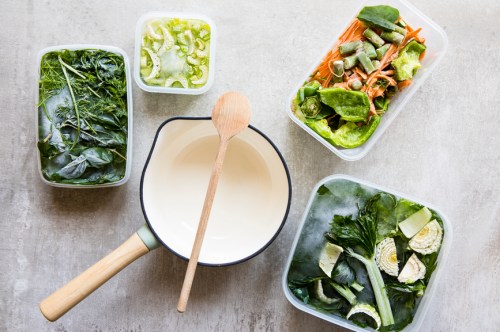The 4 Most Important Food Safety Rules To Follow When It Comes To Refreezing Foods
Here, four important frozen food safety tips to follow that will ensure you prevent frozen food from developing bacteria—or tasting terrible.

We are alllll about freezing foods. Not only do frozen foods help generate 47 percent less food waste compared to refrigerated food, but they’re a great way to eat healthy on a budget while enjoying good-for-you foods that may be out of season. Plus, no one really wants to eat dinner party leftovers for a week straight—but that frozen chili or mashed potatoes will be sounding *quite* delicious come April.
Experts in This Article
virologist and senior director of food technology communications at International Food Information Council
All of this being said, if an item has already been frozen and thawed, there are a few important frozen food safety tips to bear in mind when it comes to refreezing.
4 frozen food safety tips that will keep your precious leftovers free of bacteria (and just as flavorful as they were on day one)
1. For optimal flavor, freeze foods quickly and in small batches.
First, a note about taste. Generally, the faster something freezes, the better the quality will be. This is further aided when you freeze foods in small batches (e.g. when you fill freezer-safe containers with less than two inches deep of leftovers). When food is frozen, cell walls are ruptured and moisture escapes, which impacts flavor. Subsequent freezing sessions will further break down cell walls, so even though meat and fish refreeze very well, don’t expect that filet mignon to be packed with buttery soft flavor the third go-around.
2. How you thaw your food affects whether or not you can refreeze it.
You’ll want to be very conscious about how you thaw your frozen food before you even think about refreezing it.
When thawing frozen foods, use the refrigerator, cold water, or the microwave; avoid thawing at room temperature at all costs. “According to the FDA, bacteria naturally found in foods can multiply rapidly in unrefrigerated food, thus it’s unsafe to let food thaw at room temperature,” says Tamika D. Sims, PhD, senior director, food technology communications at the International Food Information Council. “Foods thawed in a microwave must then go on to be cooked immediately. However, if you thaw food in the refrigerator, you can store it there as recommended by the FDA.”
Foods that have been cooked after thawing can be refrigerated or re-frozen but, as mentioned, there may be a loss of quality due to the moisture lost through thawing.
These guidelines apply to frozen raw items like poultry or steak as well as previously frozen cooked foods. The agency recommends refreezing leftovers within three to four days—just be sure they are wrapped securely in foil or in a freezable airtight container.
3. Don’t freeze foods that have sat out for more than two hours.
Not all items are fair game to refreeze. The FDA advises to never refreeze any foods left outside the refrigerator longer than two hours; one hour in temperatures above 90°F. They also recommend discarding any foods that have been contaminated by raw meat juices.
4. Avoid freezing canned goods or refreezing juice concentrates.
Sims also underlines that canned goods are high on the list of items never to re-freeze—or even freeze. “This is primarily because the can packaging is not made to be frozen, and freezing can warp the can and make the food inside vulnerable to contamination from the outside environment,” Sims says. “If the can is accidentally frozen, you can thaw it in the refrigerator and then look for signs of contamination. However, if there is any doubt, it is best to throw the food out.” Finally, juice concentrates can develop bacteria quickly, so if you thaw too many, best to invite friends over for smoothies.
Lastly, remember that just because something can be refrozen, doesn’t mean that it should. We’ve yet to hear anyone rave about triple frozen bread—just sayin’.
Oh hi! You look like someone who loves free workouts, discounts for cutting-edge wellness brands, and exclusive Well+Good content. Sign up for Well+, our online community of wellness insiders, and unlock your rewards instantly.
Sign Up for Our Daily Newsletter
Get all the latest in wellness, trends, food, fitness, beauty, and more delivered right to your inbox.
Got it, you've been added to our email list.










